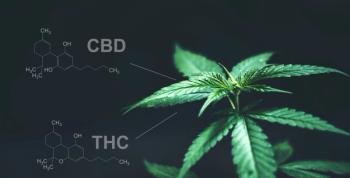
The Role of the Endocannabinoid System (ECS) in the Mind-Body Connection
This blog installment takes a look at the mind-body connection and how the endocannabinoid system (ECS) plays a key role. Topics covered include the gut, the vagus nerve, the gut-brain axis, and more.
The enteric nervous system (ENS) is a web of neurons, embedded in the walls of the gastrointestinal (GI) system, that serves as the information collection and control system that moderates digestion. The ENS has been estimated to contain more neurons than the spinal cord (1), and it is often called the “second brain” for two reasons. First, it involves so much neurotransmitter activity—95% of serotonin and 50% of dopamine activity in the body come from the gastrointestinal (GI) tract—and second, the ENS operates independently from the central nervous system (CNS), the only organ in the body capable of doing so (2).
Within the cavity of the GI tract lives a vast system of microorganisms, called the microbiome, which operates in symbiosis with the body. The vagus nerve, the second largest nerve system in the body, connects the ENS to the CNS and could be said to be the information superhighway at the heart of the mind-body connection.
Putting these four systems of activity together, the set of interactions between the ENS, the CNS, and the microbiome, which are all interlinked through the vagus nerve, has been termed the gut-brain axis (GBA) (see Figure 1). The GBA is the physical underpinning for the mind-body connection, which may very well be central to human health and well-being.
Interestingly, the endocannabinoid system (ECS) has been found to be active in moderating activity in the ENS, the CNS, and the vagus nerve, and it has been found to be active in moderating communications between the microbiome and the host. The ECS has previously been described as being central to human health as its role in serving as the master regulator of homeostasis in the body (3). It could then further be said that the ECS is central to moderating human health through another avenue: the mind-body connection.
Let’s explore these connections in a bit more detail.
The Gut
The GI tract (see Figure 2) is a principal component of the GI system (“the gut”) and runs from the esophagus to the rectum. Food enters through the mouth and as it passes along the GI tract, the food is broken down and nutrients are absorbed, and at the end of the tract any waste is eliminated from the body. A healthy GI tract is essential for ensuring the body is amply supplied with the nutrients it needs to fuel all its various activities.
The GI tract is essentially a set of concentric layers or tubes (see Figure 3) that create a path along which food travels as it’s being digested (5).
At the center of the GI tract is the lumen, the cavity where food flows. The lumen is also home to the gut microbiome, a system of trillions of microorganisms distributed throughout the GI tract. Each person’s microbiome is unique, and it’s “influenced by multiple factors, including mode of infant delivery and feeding, aging process, diet composition, geography, medications, and stress” (6). While there’s still much to learn, researchers have discovered enough to know that it lives in symbiosis with the body and plays a “vital role in normal metabolism, nutrition, immune function, physiology and prevention of disease” (7). Dysregulation of the microbiome, or dysbiosis, may cause symptoms including (8):
- Bad breath (halitosis)
- Nausea or upset stomach
- Constipation or diarrhea
- Difficulty urinating
- Vaginal or rectal itching
- Bloating
- Chest pain
- Rash or redness
- Fatigue
- Trouble thinking or concentrating
- Anxiety or depression
Notably, “increasing evidence supports the notion that the gut microbiome interacts with the ECS and that the latter plays a significant role in mediating enteric microbiota–host interactions” (9).
The intestinal epithelium is the tissue layer around the lumen that serves as a barrier between the lumen and surrounding body tissue. The epithelium plays two roles. First, it determines which particles pass through the body versus which are absorbed, and second, it mediates between gut microbiota and host tissue (10). The intestinal epithelium contains CB1 receptors, that is, the ECS helps modulate the separation and host–microbiome communication functions performed by the intestinal epithelium (11).
The submucosa is one of the layers outside the lumen. Embedded in the walls of the submucosa, together with blood and lymph vessels, is the submucosal plexus. The submucosal plexus is a neuronal web that modulates activity within the GI tract. As with the intestinal epithelium, the submucosal plexus also contains CB1 receptors (12). One of the submucosal plexus’s principal functions is to regulate mucus secretion and renewal to ensure the barrier between the lumen and the surrounding tissues remains intact. Dysregulation of this process, that is, the infiltration into areas outside the lumen by unwanted particles, contributes to GI symptoms (13,14).So, in the gut, the ECS helps moderate mucus secretion and renewal, thereby helping to prevent GI symptoms.
Among the outermost layers of the GI tract are two sets of muscles (the longitudinal muscle and the circular muscle) whose contractions propel food down the tract through a process called peristalsis (15). Embedded in the walls of the circular muscle layer is the myenteric plexus, another neuronal web that controls the muscle contractions—peristalsis—that move food along the GI tract (16). The myenteric plexus contains CB1 receptors, so the ECS also modulates GI motility (17). As with dysregulation of the mucus layer, dysregulation of peristalsis—motility disorders—can cause GI symptoms (18). Common GI symptoms and conditions include, for example (19):
- Acid reflux, heartburn, or GERD
- Indigestion
- Nausea or vomiting
- Peptic ulcers
- Abdominal pain
- Belching, bloating, or flatulence
- Gallbladder disorders
- Constipation or diarrhea
- Hemorrhoids
The Vagus Nerve
While the ENS functions independently from the CNS, the two systems are interlinked through the vagus nerve, another principal component of the digestive system (see Figure 1) (20).
The vagus is the second largest nerve system (that is, a set of neural pathways) in the body—only the spinal column is larger—and it functions to inform the brain about the state of the heart and the digestive system (21). The vagus is a bidirectional system that originates in the medulla oblongata (on the lower part of the brainstem), and helps manage, for example (22):
- Heart rate and blood pressure
- Immune response
- Respiratory rate
- Digestion
- Mood
- Speech
The vagus nerve contains CB1 receptors (23), making it yet another effectuator in the digestive process through which the ECS moderates activity.
The Gut-Brain Axis
The gut-brain axis (GBA) (see Figure 4) is the system that involves bidirectional communication between the central and enteric nervous systems; the central nervous system and the microbiota; and the enteric nervous system and the microbiota.
The abundance of neurotransmitter receptors in the brain and gut link—via the vagus and ECS—nausea, abdominal pain, and other GI disorders in the gut to anxiety, depression, and other mood disorders in the brain. Cross-talk between the microbiome and, respectively, the gut and the brain create additional links between disorders of the mind to those of the body.
Most people probably think of the GI system as being solely responsible for moving food through the body. However, once we understand its functioning, its interplay with the microbiota, and its role in the GBA, we see that it’s actually fundamental to both physical and emotional well-being. In fact, the GBA can be said to be the mind-body connection that explains why mood disorders can cause digestive disorders or vice versa. And central to gut and GBA information processing is the ECS.
References
- Enteric Nervous System (ENS). Physiopedia.
https://www.physio-pedia.com/Enteric_Nervous_System_(ENS) . - Sabater V (2021, Nov 15). The Enteric Nervous System: The Second Brain. Exploring Your Mind.
https://exploringyourmind.com/enteric-nervous-system-second-brain/ . - Lowe, H et al, The Endocannabinoid System: A Potential Target for the Treatment of Various Diseases. Int J Mol Sci. 2021, Aug 31.
https://pubmed.ncbi.nlm.nih.gov/34502379/ . https://www.nicepng.com/png/detail/78-789281_clipart-free-library-gastrointestinal-tract-human-anatomy-human.png - Tresca A (2021, Feb 22). The Anatomy of the Enteric Nervous System. Very Well Health.
https://www.verywellhealth.com/enteric-nervous-system-5112820 - Cresci G and Bawden E (2015, Dec). The Gut Microbiome: What we do and don’t know. Nutr Clin Pract.
https://www.ncbi.nlm.nih.gov/pmc/articles/PMC4838018/pdf/nihms777222.pdf - Sidhy M and van der Poorten D (2017, Apr). The Gut Microbiome. The Royal Australian College of General Practitioners.
https://www.racgp.org.au/getattachment/5a93b0d9-7183-4c4a-88a1-93a4b6c00b3d/The-gut-microbiome.aspx - What Causes Dysbiosis and How Is It Treated? Healthline.
https://www.healthline.com/health/digestive-health/dysbiosis#diagnosis - Borrelli F et al (2022, Oct 20). Editorial: Implications of gut-brain interactions for the effects of compounds derived from Cannabis or modulating the endocannabinoid system in physiological and pathological processes. Cellular Neuroscience.
https://www.frontiersin.org/articles/10.3389/fncel.2022.1042821/full - Okumura R and Takeda K (2017). Roles of intestinal epithelial cells in the maintenance of gut homeostasis. Experimental & Molecular Medicine.
https://www.nature.com/articles/emm201720 - Hasenoehrl C et al (2016, Dec). The gastrointestinal tract – a central organ of cannabinoid signaling in health and disease. Neurogastroenterol Motil.
https://www.ncbi.nlm.nih.gov/pmc/articles/PMC5130148/pdf/emss-69762.pdf - Hasenoehrl C et al (2016, Dec). The gastrointestinal tract – a central organ of cannabinoid signaling in health and disease. Neurogastroenterol Motil.
https://www.ncbi.nlm.nih.gov/pmc/articles/PMC5130148/pdf/emss-69762.pdf - Loukopoulou C (2023, Jul 10). Submucosal plexus (Meissner plexus). Kenhub.
https://www.kenhub.com/en/library/anatomy/submucosal-plexus-meissner-plexus - Herath M et al (2020). The Role of the Gastrointestinal Mucus System in Intestinal Homeostasis: Implications for Neurological Disorders. Front. Cell. Infect. Microbiol.
https://www.frontiersin.org/articles/10.3389/fcimb.2020.00248/full - Peristalsis. Cleveland Clinic.
https://my.clevelandclinic.org/health/body/22892-peristalsis - Grujičić R (2023, Apr 12). Myenteric plexus (Auerbach plexus). Kenhub.
https://www.kenhub.com/en/library/anatomy/myenteric-plexus-auerbach-plexus - Hasenoehrl C et al (2016, Dec). The gastrointestinal tract – a central organ of cannabinoid signaling in health and disease. Neurogastroenterol Motil.
https://www.ncbi.nlm.nih.gov/pmc/articles/PMC5130148/pdf/emss-69762.pdf - Peristalsis. Cleveland Clinic.
https://my.clevelandclinic.org/health/body/22892-peristalsis - Common GI Symptoms. American College of Gastroenterology.
https://gi.org/topics/common-gi-symptoms/ - Forsythe P et al (2014). Vagal pathways for microbiome-brain-gut axis communication. Adv Exp Med Biol.
https://pubmed.ncbi.nlm.nih.gov/24997031/ - Function of the Vagus Nerve (2014). Dr Sircus.
https://drsircus.com/general/function-vagus-nerve/ - Juber M (2022, Oct 6). Vagus Nerve: What to Know. WebMD.
https://www.webmd.com/brain/vagus-nerve-what-to-know - Hasenoehrl C et al (2016, Dec). The gastrointestinal tract – a central organ of cannabinoid signaling in health and disease. Neurogastroenterol Motil.
https://www.ncbi.nlm.nih.gov/pmc/articles/PMC5130148/pdf/emss-69762.pdf
About the Author
Ruth Fisher, PhD, is a systems design researcher and analyst. She analyzes markets to determine how environments shape outcomes. She is co-founder of CannDynamics, and author of The Medical Cannabis Primer and Winning the Hardware-Software Game: Using Game Theory to Optimize the Pace of New Technology Adoption. Dr. Fisher has worked in the technology and healthcare sectors on behalf of technology companies, early-stage researchers, physicians, and technology start-ups.
Newsletter
Unlock the latest breakthroughs in cannabis science—subscribe now to get expert insights, research, and industry updates delivered to your inbox.





